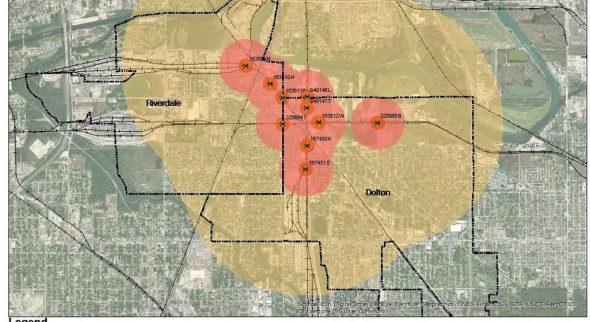Quiet zones and site refinements can help alleviate challenges borne by rail grade crossings in 2 south suburban Chicago communities, study says

A reduction in the number of required freight train horn blasts and improvements designed to enhance safety for people and vehicles would dramatically improve the quality of life for the residents of two south suburban Chicago communities. That was the focus of a recently completed research study that examined at-grade highway-railroad crossings in the towns of Dolton and Riverdale.
The study, “Quiet Zone Study for Dolton and Riverdale,” was completed by the Urban Transportation Center at UIC. The research team focused on analyzing 10 grade crossings in the two communities some 22 miles south of downtown Chicago and what could be done to minimize disruptions caused by frequent horn blasts and delays and potential safety issues resulting from frequent freight train activity. Within Dolton and Riverdale are two major railyards, and the communities are within close proximity to intermodal terminals, transit lines and expressways. Train traffic in the study area greatly varies day-by-day, and average daily train traffic ranged from 12 to 77 trains per crossing.
Approximately 51% of train traffic passes through the two towns during the evening hours, causing disruption to normal activities. For every at-grade railroad-highway grade crossing not in a Quiet Zone, locomotive engineers by regulation must make two long horn blasts, one short blast, and one long blast in advance of a crossing. If a train reaches the crossing before completing the sequence, locomotive engineers must repeat the horn blast sequence. Residents may hear hundreds of horn blasts per night. As noted in the report: “The heavy train movement and longer horn blasts in these communities are significant threat to public health and hampers social and economic development.”
Funding was provided by the South Suburban Mayors and Managers Association (SSMMA) headquartered in Hazel Crest, Illinois.
Researchers structured the study in two components: determining the optimal Supplemental Safety Measures (SSM) at each of the grade crossings that can facilitate the Quiet Zone designation process and proposing cost estimates for SSM projects. The process of determining optimal SSM at each grade crossing included input from the community along with a review of factors like the amount of traffic and pedestrian activity and unique physical characteristics at each site. Cost estimates were completed following a bus tour of the sites with SSMMA members and include project that include the installation of medians, upgrades to signals and quadrant and pedestrian gates, construction of a pedestrian overpass, and anti-trespassing signage.
The relatively high number of pedestrians and school children who traverse some grade crossings during weekdays was noted as an area of concern. For example, a 24-hour field count of the 142nd Street crossing in Dolton revealed weekday pedestrian traffic of 110 per day, “with 38% children probably because of nearby educational buildings.” Researchers learned that on average, 70 people per day, with 29% being children, used the Park Avenue and Lincoln Avenue crossing, which provides access to residences, schools, and village facilities.
The report was prepared by UTC Director Dr. P.S. Sriraj and Visiting Research Specialist Dr. Joseph Fazio. Visit this link to read an abstract and download the full report.
The Urban Transportation Center at UIC is dedicated to conducting research and education and providing technical assistance on urban transportation planning, policy, operations and management. The UTC is part of the College of Urban Planning and Public Affairs, a nationally recognized innovator in education, research and engagement in support of the nation’s cities and metropolitan areas. Learn more at www.utc.uic.edu.
Categories
